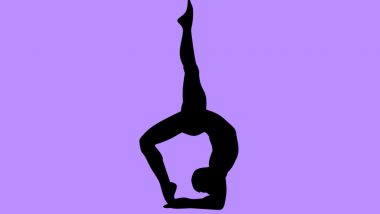On June 21, Friday, the world will celebrate the International Day of Yoga 2019. Yoga Day is observed to promote yoga as a tool for health and wellness and to encourage more people to adopt the practice for good health. Yoga has gained a lot of popularity in the past couple of decades in the west although it has been a part of Indian spiritual practice for over 3,000 years. Yoga poses or yogasanas (Yoga means "yoking" in Sanskrit) intends to promote wellness by uniting the body, mind and spirit. Dedicated practitioners believe that practising yoga can treat chronic medical conditions and mental health problems without any side effects. But medical science believes that they may be stretching the truth and there may be dangers involved with performing certain yogasanas.On This International Yoga Day 2019, let's understand the hazards of yoga. International Yoga Day 2019 Images & HD Wallpapers With Quotes for Free Download Online: Wish Happy Yoga Day With GIF Greetings & WhatsApp Stickers.
A PLoS One 2013 review studied various reported health hazards associated with yoga. Plenty of anecdotal evidence suggests that there has been a number of alarming yoga-related injuries in recent years.
Worsening of Eye Problems
If you have eye problems like glaucoma, you should never perform some types of yogasanas, especially ones that require headstands. A 2007 case of a 46-year-old woman was reported in the British Journal of Ophthalmology. The Caucasian woman who was suffering from glaucoma experienced worsening of her symptoms when she performed Sirsasana. Luckily, her health condition improved after she stopped performing asanas that required headstands.
Leg Bone Fracture
A report in the International Journal of Clinical Practice in 2004 detailed the case of a 14-year-old girl who suffered a fracture in her leg, after her distal tibia separated. She was performing Padmasana or the lotus pose. In this seated pose, both the feet are placed on the top of opposite thighs to resemble a lotus in full bloom. While Padmasana has its benefits, people with bone fractures in the leg should steer clear of it.
GERD (Gastrointestinal Reflux Disease)
Sirsasana or the headstand pose in yoga may be harmful to people who suffer from GERD. Standing on the head would send the stomach acids rushing to the oesophagus. A report by Biswas et. al in 2002 reported one such case where performing Sirsanasa and Kunjal Kriya (inducing vomiting by drinking the salty water in the morning) caused GERD.
Inflammation of the Veins
Performing difficult yogasanas without supervision can also lead to the inflammation of the veins. Extreme yoga postures can lead to blood clots just below the surface of the skin, which may get inflamed.
Hematoma
Performing certain yogasanas can also result in hematomas, an accumulation of blood in the muscles. A 2009 study reported the case of a hematoma in the abdominal muscles caused by yoga.
Psychotic Episodes
Sometimes, yogasanas have also caused psychotic episodes. Lu & Pierre et. al presented a case of a 33-year-old man who performed Bikram yoga. The study analysed how performing yoga in a heated environment worsened the subject’s psychiatric health. A 2001 study also reported maniac episodes in a 25-year-old woman as a result of performing a yogasana.
Happy Yoga Day Everyone!
Slip Disc
Many yogasanas need to be approached gradually due to their difficulty level. But sometimes, under the wrong guidance, some asasans that require excessive bending of the back like Bhujangasana or Dhanurasana can result in slip disc.
Nerve Damage
Although rare, even seemingly simple yoga postures can cause nerve damage. In a 22-year-old male, a Vajrasana pose (thunderbolt pose) ended up causing bilaeral peroneal neuropathy or nerve damage.
Sciatica
There are multiple accounts of yogasanas causing sciatica. Twisting the back leg, feet or the hips too much can put pressure on the spine, inflaming the nerves and causing sciatica.
Which Yoga Poses Are the Most Dangerous?
Of all the asanas, pranayamas were the ones which were associated with most adverse effects. The study mentioned nine case reports of worsening of the existing health conditions. Hatha yoga and Bikram yoga came next.
The asana which was considered the most high-risk pose is Sirsasana or the headstand. Others included padmasana, Kunjal Kirya, Vajrasana, Salabasana, Setu Bandhasana, Paschitmottasana and Adho Mukha Shvanasana.
While the benefits of yoga outweigh its adverse effects, it’s important for yoga enthusiasts to get proper guidance from experts. If you have existing health problems, make full disclosure about it to your yoga teacher. Rest assured, yoga is indeed a healthy way to keep your body and mind in check. On International Yoga Day 2019, let’s practice this ancient form of wellness safely.
(The above story first appeared on LatestLY on Jun 21, 2019 08:49 AM IST. For more news and updates on politics, world, sports, entertainment and lifestyle, log on to our website latestly.com).













 Quickly
Quickly






















